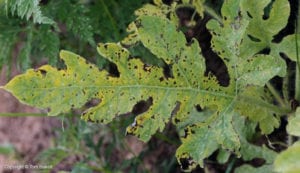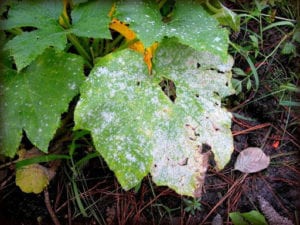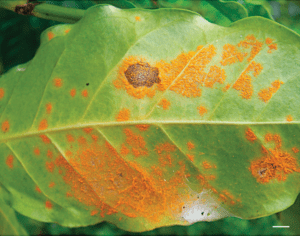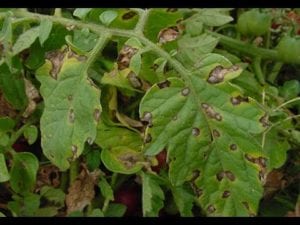Identify the diseases responsible for killing off your garden vegetables and prevent them next garden season
Gardening. What should be a relaxing hobby often becomes a stressful chore–especially when you’re tasked with fighting off bugs and diseases plaguing your garden.Earlier this summer, we recommended planting a variety of vegetables in your garden for a perfect fall harvest, but if your garden fell victim to one of these five common garden vegetable diseases, your fall harvest will likely be less than “perfect”.
We’re spotlighting five specific diseases that terrorize gardens all summer long and inhibit a bountiful fall harvest. We’ve included key points to help you identify which disease is responsible for killing off your vegetables and ways to prevent it from ruining your harvest next year too!
1. Anthracnose

This is one garden disease that’s so common, you probably didn’t even realize you had it! While Anthracnose typically attacks tree leaves, it has also been known to wreak havoc on a number of garden vegetables including, beans, tomatoes, cucumbers, spinach, and watermelon.
Anthracnose is caused by a fungi and is generally found right here in the eastern part of the United States. This disease is prompted by cool, wet weather that comes in the spring and grows steadily into the warm, humid months of summer.
Anthracnose presents lesions on the leaves of your veggies and spreads rapidly. Be sure to remove any plants infected with Anthracnose immediately to prevent further damage.
2. Powdery Mildew

Pumpkins, squash, and gourds make for some great fall recipes and decorations! If you’re growing them yourself, keep an eye out for Powdery Mildew!
This disease will present itself later in the gardening season as a flour-like dust on the leaves of your plants. Powdery Mildew likes to cling to newer, less mature plants, leaving them weaker and less likely to grow.
To protect your plants, create your own organic fertilizer made up of 40% milk and 60% water. Spraying your garden with this every 10 to 14 days can help keep disease out and your veggies growing strong!
3. Rust

This common veggie disease is notorious for latching onto vegetables like asparagus, carrots, onions, and beans.
Rust starts out as light, slightly raised spots on the leaves and stem, and over time turns into reddish-orange spots–kind of like rust on a car. While it doesn’t necessarily kill plants completely, it does a good job of stripping them of their nutrients, making them less likely to grow.
Like Anthracnose, Rust thrives in the summer when the climate is warm and humid. But that doesn’t mean that rust won’t pop up on your plants this fall! In fact, Rust is attracted to many of the veggies that are typically grown in the colder weather.
4. Club Root

Club Root is a soil-borne fungus that infects susceptible plants through their root hairs. If your cabbage, cauliflower, brussel sprouts or turnip plants are failing to grow all the way, it could be due to this garden-loving contagion.
Swollen or distorted roots are the tell-tale sign that your plant is developing Club Root. Eventually, this disease grows into the leaves, turning them yellow and causing them to drop. Unfortunately, fungicides will not protect your plants from Club Root, so a good preventative measure to take is to make sure you’re rotating your crops regularly. This will improve soil stability and lessen the chances of disease.
5. Early Blight

Early Blight is a common vegetable garden disease that LOVES to feast on tomatoes!
Like many of the other diseases, Early Blight thrives off of a moist environment, so it’s best to water your veggies in the morning so they have some time to dry off throughout the day.
This fungus disease begins as small, dark spots on the foliage and quickly grows into bigger spots with concentric rings — sort of like a bullseye! If you grow tomatoes in your garden, make sure to monitor their leaves regularly.
Because many of us grow vegetables in our garden with the purpose of eating them, we don’t want to douse our plants with harmful pesticides and treatments. Luckily, there are a few natural ways to keep these diseases out of our gardens.
3 natural ways to keep these diseases out of your garden
- Keep a clean garden
Keeping a clean garden is important for all gardens, but especially for your veggie garden. Be sure to keep up sanitation practices by picking up any plant debris, trimming away unhealthy plants, and discarding any diseased veggies!
- Maintain good air circulation
Garden diseases spread like wildfire. Be sure to plant your vegetables far enough apart so that they can have enough air flow. Plants that are too close together tend to foster a moist environment — the kind of environment that diseases love.
- Inspect plants before bringing them home
A lot of the time, garden diseases are inevitable. Make sure to look for any signs of infection before planting any vegetables in your garden and alway be sure to purchase certified seeds.
Disease can be a major problem for a garden. But if you find that your garden does NOT have one of these diseases one of these hungry bugs might be the source of your problem.
Believe it or not, your yard is still susceptible to disease even throughout the fall months. Luckily, no one knows lawns like Killingsworth. Schedule a service with our lawn care experts now!